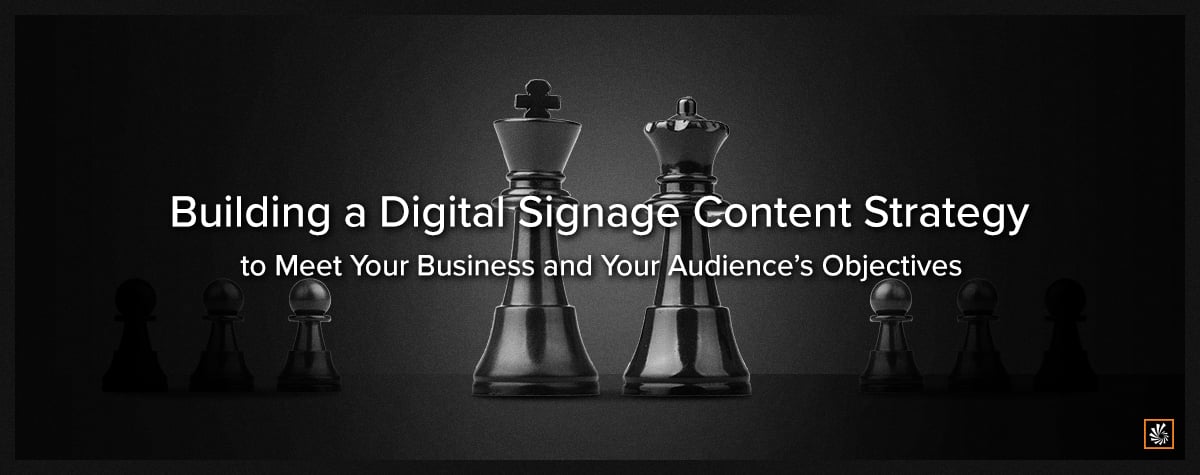Before Building a Digital Signage Content Strategy, First Recognize the Uniqueness of the Medium
We started our series on digital signage customer experience by exploring why content—not just technology—actually drives the ROI from your digital signage network. While having the latest 8K screens and touch panels looks and sounds good, content should get top billing when it comes to planning your network. It’s content that delivers the engaging, immersive experiences that bring the highest ROI, regardless of the audience.
However, before we dive into content strategies, content types, and best practices, let’s take a look at just how unique a medium digital signage really is, and how—with the appropriate digital signage content creation and management—it offers opportunities other platforms and mediums simply do not.
If you already have a good sense of your intended audience and what you want to achieve with digital signage, it can be tempting to try and directly translate tactics used with other signage mediums onto their digital versions. Simply repurposing existing content from print signage, TV screens, and online/computer screens to digital screens are all potential—but easy to make—errors. To avoid missteps and ensure engagement reaches expectations, you need to first be aware of how digital signage differs from these other media. This goes beyond physical form and the environments in which you deploy digital screens, but also in the expectations of its audience. Understanding these differences will affect your content strategy and eventually the types of content you develop and deliver.

Digital signage is like—but very unlike—TV, online, and social experiences
While digital signage shares some of the characteristics of television, using it to simply deliver no more than what a big TV could is a waste of your investment.
Unlike TV, digital signage screens are more addressable. Instead of simply pulling down whatever over-the-air feed is available, screens in a digital signage network can be identified precisely by their geographic location (GSM) and their time zone, allowing you to determine what content to display on each one. Tuning each of your screens to the same content, like they were TVs all broadcasting the same channel, is easy, but it misses out on one of the big advantages of digital signage. Because you can run specific content to specific screens scattered across a store, across a region, or the entire country you are able to create more strategic and personalized experiences that are both engaging and interactive.
Different shoppers, employees, and other audiences need different information and experiences at different times. Unlike television broadcasts, digital signage doesn’t have to be a one-size-fits-all message, where every device in every location gets the same programming. You might, for example, tune all your TV’s to a weather channel, but shoppers in Texas aren’t interested in waiting through the weather in the Northeast or in the Hawaiian Islands. A digital screen could smartly and automatically display the local weather near where the sign is located.
The digital signage experience shouldn’t be exactly like the one you’d get online either. Digital screens are far more than an oversized web browser. The typical online experience is often personalized based on a user’s location and device type. Online shopping is also highly interactive. Both of those are great things. However, online searches can take shoppers anywhere, not just to your content. Digital screens, though, can provide dynamic content like an online experience, but focused squarely on your brand. And again, because each digital screen is individually addressable, you are able to further focus your message down to each location, each department, and each screen.

The audience and environment are also different
It isn’t just that the medium itself and what you can deliver with it that is different. The audience and the environment in which you deploy digital signage is fundamentally from TV and online experiences. Your audience—customers, employees, and so on—isn’t sitting at home at a desk surfing the web. They aren’t reclining on their sofa flipping through cable TV channels. They are right in your place of business, in person, working, shopping, waiting for your services. This means they have a more direct path to action than normal, whether that’s work related or purchasing.
Also, digital signage is part of the overall environment and physical experience, meaning you much give more thought to how it will align with the rest of your physical space. Do want it to blend in or stand out? Do you want it to cause your audience to linger, or direct traffic to other parts of your space?
Understanding these differences will naturally drive to more thoughtful, effective, and experiential content.

Digital signage is simply more effective than other mediums
With digital screens, you can deliver the specific messages and experiences you want your audience to receive, in the locations where they will be most effective. Unlike both TV and online, you can configure your displays to play different content based on time of day, day of week, exact location, and even change dynamically based on who is viewing and interacting with them.
One more thing. Our brains quickly become desensitized to static messages and images, whether on paper signage or screens. People really key into motion graphics—they grab a viewer’s attention and hold it. In fact, video and animated graphics make 64% of consumers more likely to buy a product. Digital signage can present an engaging combination of motion graphics, videos, static images, and text, all at the same time—and far more tailored to location-based venues than either TV or online.
That’s why digital signage is simply more effective than static paper signage, TV, online, or a combination of all of them. With the proper content strategy, content creation, and content management, digital signage can outperform these other media, whether it is deployed in retail, manufacturing, corporate offices, medical facilities, or anywhere else.
Does it work? Consider that:
- The human brain processes visual information up to 60,000 times faster than text.
- A whopping 63 percent of consumers see digital signage every day.
- Studies show digital signs capture 400% more attention than static signs.
The business impact is real and measurable. A report by Digital Signage Today shows that exposure to digital signage can:
- Increase consumer brand awareness by 48%,
- Increase sales by 33 % and repeat sales by 32.8%,
- Increase average spend by 29.5%.
Recognize the differences, then plan to take advantage of them
Knowing how digital signage goes beyond other types of signage—not to mention better delivering on your business goals—is the first step. Now, how do you actually get started? Next time we’ll look at the importance of digital signage content strategy: what it looks like, and why and how you should develop one before (not after) you start ordering all those new screens.
In the meantime, we invite you to connect with us on LinkedIn Better yet, contact us to find out how Reflect Systems and its products and solutions—including our ReflectView digital signage platform—can help ensure you get the best possible ROI from your digital signage network and your content.
Share this
You May Also Like
These Related Stories
%20is%20Key%20to%20a%20Successful%20ROI%20on%20Your%20Digital%20Signage%20Investment%202.jpg)
Content (Not Technology) is Key to a Successful ROI on Your Digital Signage Investment

Building a Digital Signage Content Strategy to Meet Your Business’ and Your Audience’s Objectives


